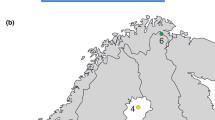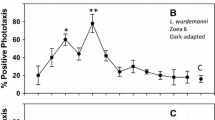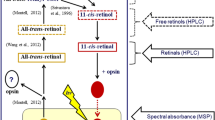Abstract
The temporal characteristics of the visual systems of deep-sea crustaceans were examined at varying light levels. Experimental organisms were collected off Hawaii and southern California in 1991 and 1992, and continually maintained in the dark. At the University of California Santa Barbara Marine Laboratory, the temporal components of both visual interneuron activity and electroretinograms (ERGs) of adult Gnathophausia ingens were tested at threshold and with background light levels up to 6 log units above threshold. To compare these responses with those of mid-water organisms inhabiting shallower depths, the temporal characteristics of the ERGs of Oplophorus spinosus and juvenile G. ingens were assessed. Adults of both species showed little or no change in the time components of their responses when light-adapted, except for the response latency. There was also no evidence of a circadian rhythm in visual sensitivity. O. spinosus, a vertical migrator, and juvenile G. ingens, which inhabit a shallower depth than the adults, exhibited more rapid responses than adult G. ingens. These varying responses are considered adaptations to the differences in light levels at the characteristic depths of the organisms.
Similar content being viewed by others
References
Aho AC, Donner K, Helenius S, Larsen LO, Reuter T (1993) Visual performance of the toad (Bufo bufo) at low light levels: retinal ganglion cell responses and prey-catching accuracy. J comp Physiol 172: 671–682
Aho AC, Donner K, Hyden C, Larsen LO, Reuter T (1988) Low retinal noise in animals with low body temperature allows high visual sensitivity. Nature, Lond 334: 348–350
Autrum H (1981) Light and dark adaptation in invertebrates. In: Autrum H (ed) Handbook of sensory physiology. Vol VII/6C. Springer, Berlin, Heidelberg, New York, pp 1–91
Ball EE, Kao LC, Stone RC, Land MF (1986) Eye structure and optics in the pelagic shrimp Acetes sibogae (Decapoda, Natantia, Sergestidae) in relation to light-dark adaptation and natural history. Phil Trans R Soc (Ser B) 313: 251–270
Barlow RB, Jr, Chamberlain SC, Lehman HK (1989) Circadian rhythms in the invertebrate retina. In: Stavenga DG, Hardie RC (eds) Facets of vision. Springer-Verlag, Berlin, Heidelberg, New York, pp 257–280
Barlow RB, Jr, Kaplan E, Renninger GH, Saito T (1987) Circadian rhythms in Limulus photoreceptors. J gen Physiol 89: 353–378
Behrens M, Krebs W (1976) The effect of light-dark adaptation on the ultrastructure of Limulus lateral eye retinular cells. J comp Physiol 107: 77–96
Case JF (1984) Vision in mating behaviour of fireflies. In: Lewis T (ed) Insect communication: 12th Symposium Royal Entomological Society of London. Academic Press, London, pp 195–222
Case JF, Haddock SHD, Harper RD (1994) The ecology of bioluminescence. In: Campbell AK, Kricka LJ, Stanley PE (eds) Bioluminescense and chemiluminescence: fundamentals and applied aspects. John Wiley & Sons, New York, pp 115–122
Case JF, Widder EA, Bernstein S, Ferer K, Young D, Latz MI, Geiger M, Lapota D (1993) Assessment of marine bioluminescence. Naval Res Rev 45: 31–41
Childress JJ, Barnes AT, Quentin LB, Robison BH (1977) Thermally protecting cod ends for the recovery of living deep-sea animals. Deep-Sea Res 25: 419–422
Childress JJ, Price MH (1978) Growth rate of the bathypelagic crustacean Gnathophausia ingens (Mysidacea: Lopogastridae). I. Dimensional growth and population structure. Mar Biol 50: 47–62
Cronin TW (1992) Visual rhythms in stomatopod crustaceans observed in the pseudopupil. Biol Bull mar biol Lab, Woods Hole 182: 278–287
Donner K (1989) Visual latency and brightness: an interpretation based on the responses of rods and ganglion cells in the frog retina. Vis Neuro 3: 39–51
Dubs A (1982) The spatial integration of signals in the retina and lamina of the fly compound eye under different conditions of luminance. J comp Physiol 146: 321–343
Edmunds LN, Jr (1988) Cellular and molecular bases of biological clocks. Springer-Verlag, New York, Berlin, Heidelberg
Fein A, Payne R (1989) Phototransduction in Limulus ventral photoreceptors: roles of calcium and inositol trisphosphate. In: Stavenga DG, Hardie RC (eds) Facets of vision. Springer-Verlag, Berlin, Heidelberg, New York, pp 173–185
Frank TM, Case JF (1988a) Visual spectral sensitivity of bioluminescent deep-sea crustaceans. Biol Bull mar biol Lab, Woods Hole 175: 261–273
Frank TM, Case JF (1988b) Visual spectral sensitivity of the bioluminescent deep-sea mysid, Gnathophausia ingens. Biol Bull mar biol Lab, Woods Hole 175: 274–283
Frank TM, Widder EA (1994) Evidence for behavioral sensitivity to near-UV light in the deep-sea crustacean Sytellaspis debilis. Mar Biol 118: 279–284
Hamasaki DI (1968) The electroretinogram of the intact anesthetized octopus. Vision Res 8: 247–258
Herring PJ (1976) Bioluminescence in decapod crustacea. J mar biol Ass UK 56: 1029–1047
Itaya SK (1976) Rhabdom changes in the shrimp, Palaemonetes. Cell Tissue Res 166: 265–273
Lamprecht G, Weber F (1977) Die Lichtempfindlichkeit die circadianen Rhythmik dreier Hohlenkäfer Arten der Gattung Laemostenus. J Insect Physiol 23: 445–452
Laughlin SB (1976) The sensitivities of dragonfly photoreceptors and the voltage gain of transduction. J comp Physiol 111: 221–247
Laughlin SB (1981) Neural principles in the peripheral visual systems of invertebrates. In: Autrum H (ed) Handbook of sensory biology. Vol VII/6B. Springer-Verlag, Berlin, Heidelberg, New York, pp 133–280
Laughlin SB (1990) Invertebrate vision at low luminances. In: Hess RF, Sharpe LT, Nordby K (eds) Night vision. Cambridge University Press, Cambridge, pp 223–250
Mansfield RJW (1973) Latency functions in human vision. Vision Res 13: 2219–2234
Moeller JF, Case JF (1994) Properties of visual interneurons in a deep-sea mysid, Gnathophausia ingens. Mar Biol 119: 211–219
Payne R, Howard J (1981) Response of an insect photoreceptor: a simple log-normal model. Nature, Lond 290: 415–416
Ratliff F, Hartline HK (1974) Studies on excitation and inhibition in the retina. Chapman & Hall, London
Rensing L, Jaeger NI (1985) Temporal order. Springer-Verlag, Berlin, Heidelberg
Shelton PMJ, Gaten E, Chapman CJ (1985) Light and retinal damage in Nephrops norvegicus (L.) (Crustacea). Proc R Soc (Ser B) 226: 217–236
Sokal RR, Rohlf FJ (1981) Biometry. The principles and practice of statistics in biological research. 2nd edn. W.H. Freeman & Co, New York
Spieler RE (1992) Feeding-entrained circadian rhythms in fishes. In: Ali MA (ed) Rhythms in fishes. Plenum Press, New York, pp 137–147
Srinivasan MV, Laughlin SB, Dubs A (1982) Predictive coding: a fresh view of inhibition in the retina. Proc R Soc (Ser B) 216: 427–459
Stowe S (1981) Effects of illumination changes on rhabdom synthesis in a crab. J comp Physiol 142: 19–25
Wallace DC (1976) Feeding behavior and development, seasonal and diel changes in the food of the silverjaw minnow, Ericymba buccata Cope. Am Midl Nat 95: 361–376
Waterman TH, Wiersma CAG, Bush BMH (1964) Afferent visual responses in the optic nerve of the crab. J cell comp Physiol 63: 135–155
Wiersma CAG, Yamaguchi T (1966) The neuronal components of the optic nerve of the crayfish by single unit analysis. J comp Neurol 128: 333–358
Zieman DA (1975) Patterns of vertical distribution, vertical migration, and reproduction in the Hawaiian mesopelagic shrimp of the family Oplophoridae. Thesis. University of Hawaii, Honolulu
Author information
Authors and Affiliations
Additional information
Communicated by M.F. Strathmann, Friday Harbor
Rights and permissions
About this article
Cite this article
Moeller, J.F., Case, J.F. Temporal adaptations in visual systems of deep-sea crustaceans. Marine Biology 123, 47–54 (1995). https://doi.org/10.1007/BF00350322
Received:
Accepted:
Issue Date:
DOI: https://doi.org/10.1007/BF00350322




